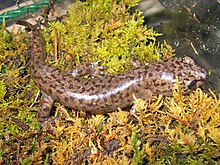Dicamptodon tenebrosus
| Dicamptodon tenebrosus | ||||||||||||
|---|---|---|---|---|---|---|---|---|---|---|---|---|

Dicamptodon tenebrosus , dark form |
||||||||||||
| Systematics | ||||||||||||
|
||||||||||||
| Scientific name | ||||||||||||
| Dicamptodon tenebrosus | ||||||||||||
| ( Baird & Girard , 1852) |
Dicamptodon tenebrosus , sometimes called Pacific giant salamander or in English as Coastal giant salamander called (coastal giant salamander), is native to North America tailed amphibian (caudata) from the superfamily of Salamander relatives (Salamandroidea).
features
Dicamptodon tenebrosus can reach a total length of just over 30 centimeters, with the tail making up about 40% of it. This is flattened and thus makes it easier for the amphibians to move in the water. The skin is smooth and shiny. The head, back and flanks show a strong, irregular and unmistakable, red-brown to dark-brown marbling on a light brown or gray-brown background. Depending on the intensity of the brown color, there are light and dark forms. The belly is colored slate gray to light brown without drawing. The animals have a wide, shovel-shaped mouth. Your front feet have four fingers and the back feet have five toes. The iris of the large eyes is brass-colored, the pupil black.
distribution and habitat
The distribution area of Dicamptodon tenebrosus extends from the coastal regions in northern California via Oregon and Washington to southern British Columbia in Canada . Adult animals live in moist forests under rocks, roots and trunks, near mountain streams or on the rocky banks of mountain lakes. Their larvae prefer to live in clear, cool or cold, oxygenated waters and they like to take cover under stones or water plants. The altitude distribution ranges from sea level to 2160 meters.
Way of life and development
Adult individuals feed on various insects and worms, as well as small mice or snakes. Their young animals, which live in the water and have gills , eat the larvae of aquatic insects as well as worms, snails, tadpoles or small fish. Between spring and autumn, after mating, the females lay groups of 85 to 200 eggs in nests beneath the water surface or attach them to plants and stones next to them. The eggs are white in color and 15 to 20 millimeters in diameter. The female stays near the nest for about 200 days to guard the brood and protect it from cannibalistic males or other predators. The development time of the young animals extends over several years and depends on environmental conditions, sediment contamination, water temperature and flow speed as well as the food supply. It takes an average of three to four years for the young to leave the water. The animals become sexually mature after five or six years. Sometimes neoteny also occurs. The predators include garter snakes ( Thamnophis ), otters (Lutrinae) and weasel species , water shrews ( Neomys ) and the dolly varden trout ( Salvelinus malma ).
Danger
In the USA , the species is not acutely endangered and is therefore classified by the World Conservation Organization IUCN as ![]() ( least concern = not endangered). In British Columbia, however, it is considered endangered and the collection or killing of Dicamptodon tenebrosus is prohibited under the Wildlife Act of British Columbia .
( least concern = not endangered). In British Columbia, however, it is considered endangered and the collection or killing of Dicamptodon tenebrosus is prohibited under the Wildlife Act of British Columbia .
Individual evidence
- ↑ a b c d e Donald A. Blood: Pacific Giant Salamander , Province of British Columbia, Ministry of Environment, Lands and Parks, 1993, ISBN 0-7726-7411-6 http: //www.env.gov.bc. ca / wld / documents / salamander.pdf
- ↑ occurrence
- ↑ a b c d Barbara E. Johnston: Coastal Giant Salamander , Accounts and Measures for Managing Identified Wildlife - Accounts V. 2004 http://www.env.gov.bc.ca/wld/frpa/iwms/documents/Amphibians/ a_coastalgiantsalamander.pdf
- ↑ development
- ^ Red List
Web links
- California salamanders - photos
- eol.org - Encyclopedia of Life
